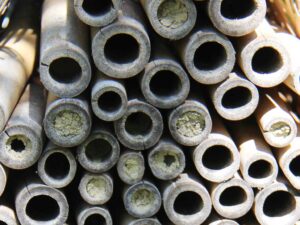La Vida Local
Irregular Notes on West End Life
What’s That Buzz?
By Rosanne Graef
An undeniable urge to dig always strikes me about mid-April. It’s getting to the 50°s by day and overnight hovers a few degrees above freezing. It’s time to haul out the lifetime trove of gardening accoutrements: such valuables as strips of ancient t-shirts, unmatched separated sections of wire edging, generations of worn-out gloves, and my beloved handheld garden fork with the smooth wooden handle that fits just right. During the process of assembling these materials, one of my fondest aspirations was realized. But first, let’s go back around six to seven years to when I purchased a tear-drop shaped bee house made of woven rattan and bamboo.
My Bee House
Having securely mounted it to catch the morning sun, have protection from driving rain and enjoy plentiful access to pollen and nectar from our grass-free yard and other floral buffets in the immediate neighborhood, the waiting began. No sign of interest. Not even a fly-by. The unused bee house sat there, quietly decomposing, until spring 2022 when we lashed it together with blue painter’s tape for one final try at attracting some tenants.

Maybe it was that touch of color, but for whatever reason our bee house was on the map in Spring 2022. By the end of the six-week mating and pollinating season, eighteen of the nesting tubes were occupied and capped. Who were these long-awaited guests? Mason bees. In contrast to the social honeybees that live together in hives and have a strict division of labor among queens, drones, and workers, mason bees are solitary. Each female has to do the work of finding a home, building, and provisioning a nest for each egg she lays all on her own. The males don’t do much other than mate with the females.
Although independent, the girls do like to live together, each with her own nesting tubes. A female makes around twenty-five trips gathering nectar and pollen to mix and form a nutritional loaf upon which she will lay a single egg. She then gathers mud and builds a partition in the tube to seal off the developing egg. (The name mason bee comes from this construction method.) This is repeated until the tube is filled with five to seven individual cells, each holding an egg and its food supply.
Mason Bees Proceed
Fast forward now through metamorphosis from egg to larva to pupa, through winter dormancy, to mid-April 2023. I open the door to the shed where the nesting tubes have spent five months, and there they are—a couple of bees exploring the shelf. Ring those bells! Time to take them outside to mate and nest.
In their approximately six-week lifespan, female mason bees can lay thirty to thirty-five eggs in several nesting tubes. They can visit 2,000 flowers daily. Not only are they gathering pollen for their future offspring, but they are also spreading pollen everywhere they go. When you eat a Maine blueberry or apple, chances are a mason bee made it happen. On top of all that, they don’t sting and are lots of fun once they finally find you.





